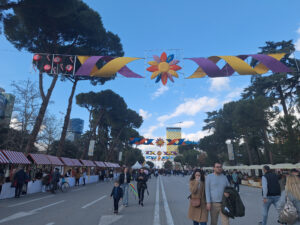Summer Day, a unique festive day of Albania
Summer Day is the most unique festival in Albania, celebrated yearly on 14 March.
It has been celebrated massively throughout the country in the last decade, but its roots are deep in ancient times in Elbasan.
Every year on March 14, Albanians celebrate Dita e Verës (Summer Day), the country’s largest pagan festival. People celebrate the end of winter, the rebirth of nature, and a rejuvenation of spirit among Albanians. Although the epicenter of this festival is around the Shkumbin region in Elbasan, the festival is widely celebrated in Tirana. In 2004, Summer Day became an official holiday in Albania. On this day and ever since March 1st, many people usually wear a traditional bracelet called Verore (a word derived from summer) made of two thin braided strings, typically red and white. The bracelet is hung on a tree branch for good luck, and is believed that birds use it to build their nests.


The history
Dita e Veres is one of the oldest traditional days, mainly celebrated in Elbasan. This festival’s origin is traced to the Mountain Muse (Zana Malit) temple, built near Shkumbin (Elbasan). Muse was the goddess of hunting, forests, and nature, and she would come out of her temple only on March 14, which marked the beginning of the summer. This legend was passed from generation to generation, and the Summer Day festival is known for its unique cultural heritage and traditions. This popular celebration was a tradition that today identifies the city of Elbasan, known for its extraordinary cultural traditions.
It is a community-wide event, with families often exchanging the traditional Ballokume, a sugar and corn flour cookie. Each family has its recipe, considered a source of pride. Some decades ago, people went to Elbasan to celebrate this day, but now it has become a national festival. In every city, people celebrate the end of winter in a very festive atmosphere, and the tradition of cooking bollokume has now expanded from the north to the south of Albania.


Other News to Read
Heritage is Our Brand- a project or a mission
Albanians’ intangible heritage is wealthy, starting with their language, national symbols, folklore, costumes, legends, ballads, dances, rites, and…
The Holy Month of Ramazan in Albania
On March 1, Muslim believers worldwide, including Albania, Kosovo, and North Macedonia, started the extraordinary spiritual journey: the…
Guardians of the Underground: Why Albania Needs Its Cave Explorers
Deep beneath Albania’s rugged mountains lies a hidden world few have seen: an underground realm of extraordinary caves,…
What to do in March in Tirana
As winter bids farewell and the first hints of spring emerge, Tirana transforms into a canvas of colors…